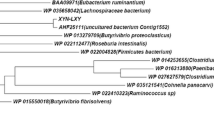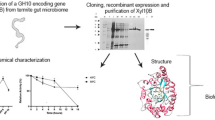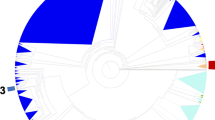Abstract
A metagenomic library was generated using microbial DNA extracted from the rumen contents of a grass hay-fed dairy cow using a bacterial artificial chromosome-based vector system. Functional screening of the library identified a gene encoding a potent glycoside hydrolase, xyn10N18, localised within a xylanolytic gene cluster consisting of four open-reading frames (ORFs). The ORF, xyn10N18, encodes an endo-β-1,4-xylanase with a glycosyl hydrolase family 10 (GH10) catalytic domain, adopts a canonical α8/ß8-fold and possesses conserved catalytic glutamate residues typical of GH10 xylanases. Xyn10N18 exhibits optimal catalytic activity at 35 °C and pH 6.5 and was highly stable to pH changes retaining at least 85 % relative catalytic activity over a broad pH range (4.0–12.0). It retained 25 % of its relative activity at both low (4 °C) and high (55 °C) temperatures, however the stability of the enzyme rapidly decreased at temperatures of >40 °C. The specific activity of Xyn10N18 is enhanced by the divalent cations Mn2+ and Co2+ and is dramatically reduced by Hg2+ and Cu2+. Interestingly, EDTA had little effect on specific activity indicating that divalent cations do not function mechanistically. The enzyme was highly specific for xylan containing substrates and showed no catalytic activity against cellulose. Analysis of the hydrolysis products indicated that Xyn10N18 was an endoxylanase. Through a combination of structural modelling and in vitro enzyme characterisation this study provides an understanding of the mechanism and the substrate specificity of this enzyme serving as a starting point for directed evolution of Xyn10N18 and subsequent downstream use in industry.





Similar content being viewed by others
References
Ali MK, Rudolph FB, Bennett GN (2004) Thermostable xylanase10B from Clostridium acetobutylicum ATCC824. J Ind Microbiol Biotechnol 31:229–234
Ashkenazy H, Erez E, Martz E, Pupko T, Ben-Tal N (2010) ConSurf 2010: calculating evolutionary conservation in sequence and structure of proteins and nucleic acids. Nucl Acids Res 38:W529–W533
Beg QK, Kapoor M, Mahajan L, Hoondal GS (2001) Microbial xylanases and their industrial applications: a review. Appl Microbiol Biotechnol 56:326–338
Biely P (1985) Microbial xylanolytic systems. Trends Biotechnol 11:286–290
Burnett GS (1966) Studies of viscosity as the probable factor involved in the improvement of certain barleys for chickens by enzyme supplementation. Br Poult Sci 7:55–75
Chang L, Ding M, Bao L, Chen Y, Zhou J, Lu H (2011) Characterization of a bifunctional xylanase/endoglucanase from yak rumen microorganisms. Appl Microbiol Biotechnol 90:933–1942
Choct M, Annison G (1990) Anti-nutritive activity of wheat pentosans in broiler diets. Br Poult Sci 31:811–821
Choct M, Annison G (1992) Anti-nutritive effect of wheat pentosans in broiler chickens: roles of viscosity and gut microflora. Br Poult Sci 33:821–834
Collins T, Gerday C, Feller G (2005) Xylanases, xylanase families and extremophilic xylanases. FEMS Microbiol Rev 29:3–23
Decelle B, Tsang A, Storms RK (2004) Cloning, functional expression and characterization of three Phanerochaete chrysosporium endo-1, 4-β-xylanase. Curr Genet 46:166–175
Ferrer M, Golyshina OV, Chernikova TN, Khachane AN, Reyes-Duarte D, Santos VA, Strompl C, Elborough K, Jarvis G, Neef A, Yakimov MM, Timmis KN, Golyshin PN (2005) Novel hydrolase diversity retrieved from a metagenome library of bovine rumen microflora. Environ Microbiol 7:1996–2010
Gerday C, Aittaleb M, Bentahir M, Chessa JP, Claverie P, Collins T, D’Amico S, Dumont J, Garsoux G, Georlette D, Hoyoux A, Lonhienne T, Meuwis MA, Feller G (2000) Cold-adapted enzymes: from fundamentals to biotechnology. Trends Biotechnol 18:103–107
Haegeman A, Vanholme B, Gheysen G (2009) Characterization of a putative endoxylanase in the migratory plant-parasitic nematode Radopholus similis. Mol Plant Pathol 10:389–401
Han S, Yukawa H, Inui M, Doi R (2004) Isolation and expression of the xynB gene and its product, XynB, a consistent component of the Clostridium cellulovorans cellulosome. J Bacteriol 186:8347–8355
Krause DO, Denman SE, Mackie RI, Morrison M, Rae AL, Attwood GT, McSweeney CS (2003) Opportunities to improve fiber degradation in the rumen: microbiology, ecology, and genomics. FEMS Microbiol Rev 27:663–693
Laemmli UK (1970) Cleavage of structural proteins during the assembly of the head of bacteriophage T4. Nature 227:680–685
Li C, Hong Y, Shao Z, Lin L, Huang X, Liu P, Wu G, Meng X, Liu Z (2009) Novel alkali-stable, cellulase-free xylanase from deep-sea Kocuria sp. Mn22. J Microbiol Biotechnol 19:873–880
Luo H, Yang J, Li J, Shi P, Huang H, Bai Y, Fan Y, Yao B (2010) Molecular cloning and characterization of the novel acidic xylanase XYLD from Bispora sp. MEY-1 that is homologous to family 30 glycosyl hydrolases. Appl Microbiol Biotechnol 86:1829–1839
Maalej I, Belhaj I, Masmoudi NF, Belghith H (2009) Highly thermostable xylanase of the thermophilic fungus Talaromyces thermophilus: purification and characterization. Appl Biochem Biotechnol 158:200–212
Menon V, Prakash G, Prabhune A, Rao M (2010) Biocatalytic approach for the utilization of hemicellulose for ethanol production from agricultural residue using thermostable xylanase and thermotolerant yeast. Bioresour Technol 101:5366–5373
Miller GL (1959) Use of dinitrosalicylic acid reagent for determination of reducing sugar. Anal Chem 31:426–428
Mirande C, Mosoni P, Béra-Maillet C, Bernalier-Donadille A, Forano E (2010) Characterization of Xyn10A, a highly active xylanase from the human gut bacterium Bacteroides xylanisolvens XB1A. Appl Microbiol Biotechnol 87:2097–2105
Palackal N, Lyon CS, Zaidi S, Luginbühl P, Dupree P, Goubet F, Macomber JL, Short JM, Hazlewood GP, Robertson DE, Steer BA (2007) A multifunctional hybrid glycosyl hydrolase discovered in an uncultured microbial consortium from ruminant gut. Appl Microbiol Biotechnol 74:113–124
Pell G, Taylor EJ, Gloster TM, Turkenburg JP, Fontes C, Ferreira L, Nagy T, Clark SJ, Davies GJ, Gilbert HJ (2004) The mechanism by which family 10 glycoside hydrolases bind decorated substrates. J Biol Chem 279:9597–9605
Polizeli ML, Rizzatti ACS, Monti R, Terenzi HF, Jorge JA, Amorim DS (2005) Xylanases from fungi: properties and industrial applications. Appl Microbiol Biotechnol 67:577–591
Pollet A, Delcour JA, Courtin CM (2010) Structural determinants of the substrate specificities of xylanases from different glycoside hydrolase families. Crit Rev Biotechnol 30:176–191
Selinger LB, Forsberg CW, Cheng KJ (1996) The rumen: a unique source of enzymes for enhancing livestock production. Anaerobe 2:263–284
Shrinivas D, Savitha G, Raviranjan K, Naik GR (2010) A highly thermostable alkaline cellulase-free xylanase from thermoalkalophilic Bacillus sp. JB 99 suitable for paper and pulp industry: purification and characterization. Appl Biochem Biotechnol 162:2049–2057
Söding J, Biegert A, Lupas AN (2005) The HHpred interactive server for protein homology detection and structure prediction. Nucleic Acids Res 33:W244–W248
Wallner B, Elofsson A (2003) Can correct protein models be identified? Protein Sci 12:1073–1086
Wang G, Luo H, Wang Y, Huang H, Shi P, Yang P, Meng K, Bai Y, Yao B (2011) A novel cold-active xylanase gene from the environmental DNA of goat rumen contents: direct cloning, expression and enzyme characterization. Biores Technol 102:3330–3336
Wood PJ, Erfle JD, Teather RM (1988) Use of complex formation between congo red and polysaccharides in the detection and assay of polysaccharide hydrolases. Meth Enzymol 160:59–74
Zhao S, Wang J, Bu D, Liu K, ZhuY DZ, Yu Z (2010) Novel glycoside hydrolases identified by screening a chinese holstein dairy cow rumen-derived metagenome library. Appl Environ Microbiol 76:6701–6705
Zolotnitsky G, Cogan U, Adir N, Solomon V, Shoham G, Shoham Y (2004) Mapping glycoside hydrolase substrate subsites by isothermal titration calorimetry. Proc Natl Acad Sci USA 101:11275–11280
Acknowledgements
This work was conducted under the research fund from the Agricultural Bioproducts Initiative Program (ABIP) Cellulosic Biofuels Network (CBioN) and Canadian Triticale Biorefinery Initiative (CTBI) of Agriculture and Agri-Food Canada and the genomics program of Genome Alberta. The authors would like to thank Krysty Munns for assistance with the editing and submission of this manuscript and Lyn Paterson for technical assistance.
Author information
Authors and Affiliations
Corresponding author
Additional information
X. Gong and R. J. Gruniniger contributed equally to this work.
Rights and permissions
About this article
Cite this article
Gong, X., Gruniniger, R.J., Forster, R.J. et al. Biochemical analysis of a highly specific, pH stable xylanase gene identified from a bovine rumen-derived metagenomic library. Appl Microbiol Biotechnol 97, 2423–2431 (2013). https://doi.org/10.1007/s00253-012-4088-y
Received:
Revised:
Accepted:
Published:
Issue Date:
DOI: https://doi.org/10.1007/s00253-012-4088-y




